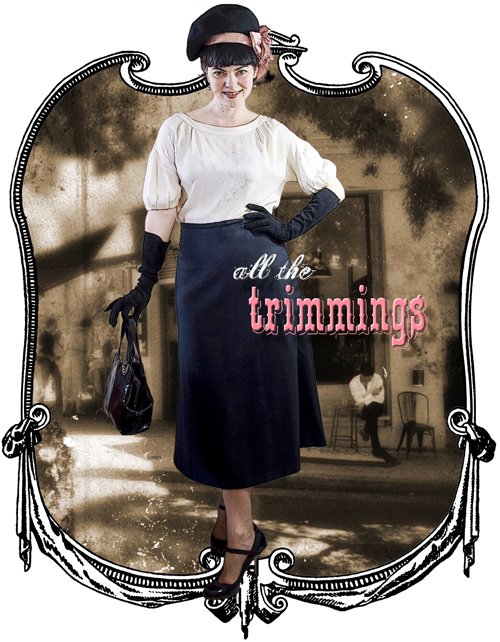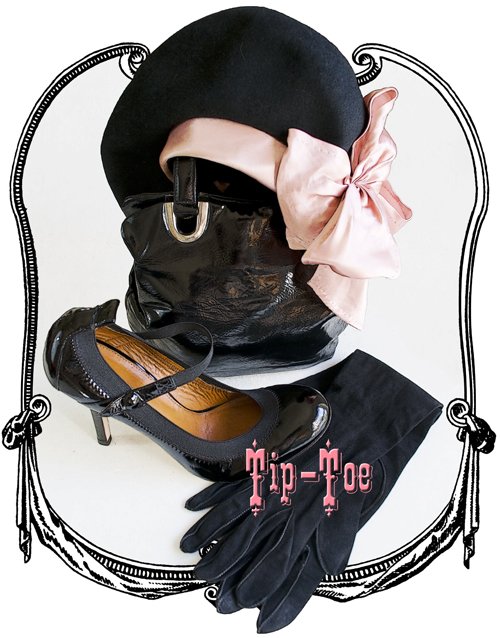New Look, Old Rules
 Reminiscent of the full-skirted New Look of the 40s: silk blouse by Veronika Maine, wool skirt by Sü, 40s hat and gloves, 60s bag, stockings by Levante, shoes by BCBGOh how times have changed, and thank goodness for that! Though there is much to love about vintage fashion and style, I am so happy that the all-pervading enslavement to fashion rules and regulations that once held sway over women has been laid to rest.
Reminiscent of the full-skirted New Look of the 40s: silk blouse by Veronika Maine, wool skirt by Sü, 40s hat and gloves, 60s bag, stockings by Levante, shoes by BCBGOh how times have changed, and thank goodness for that! Though there is much to love about vintage fashion and style, I am so happy that the all-pervading enslavement to fashion rules and regulations that once held sway over women has been laid to rest.
Once, an elegant woman could not venture upon the street without her matching hat, gloves, shoes and bag. Moreover, there were separate sets for town and country, for sporting kit and dressy ensembles. These sets were comprised of all black items, (in addition, if possible, a set all in brown) and beige shoes with a straw handbag for summer.
In A Guide to Elegance (Harper Collins, 2003 ed.), Genevieve Antoine Dariaux opens the section on accessories with: ‘The accessories worn with an outfit – gloves, hat, shoes, and handbag – are among the most important elements of an elegant appearance. A modest dress or suit can triple its face value when it is worn with an elegant hat, bag, gloves and shoes, while a designer’s original can lose much of its prestige if its accessories have been carelessly selected.’
 This sounds fine … at first glance. But read on and learn, for instance, that alligator was only worn with casual outfits (it would be vulgar and nouveau riche to carry an expensive alligator bag with dressy clothes); trousers should never be worn with a heel, rather ballerinas or moccasins; and coloured shoes were suitable with evening dresses and nothing else, while white were worn only in summer with a white dress (and never in the city, except in the tropics). Preferably, gloves should be glacé kidskin, followed by suede and antelope (which need to be replaced often to remain fresh), and good quality nylon. Crocheted lace or transparent nylon gloves were an abomination. As for novelty handbags: Out.
This sounds fine … at first glance. But read on and learn, for instance, that alligator was only worn with casual outfits (it would be vulgar and nouveau riche to carry an expensive alligator bag with dressy clothes); trousers should never be worn with a heel, rather ballerinas or moccasins; and coloured shoes were suitable with evening dresses and nothing else, while white were worn only in summer with a white dress (and never in the city, except in the tropics). Preferably, gloves should be glacé kidskin, followed by suede and antelope (which need to be replaced often to remain fresh), and good quality nylon. Crocheted lace or transparent nylon gloves were an abomination. As for novelty handbags: Out.
These are the shoes Dariaux lists as having no place in the elegant woman’s wardrobe:
- too high heels (vulgar – 2.5 inches max);
- open-toed shoes (toes might get stepped on, or wet in the rain);
- wedge heels (awkward, with transparent heels being in particularly bad taste);
- ankle straps (unflattering and cheap-looking);
- extra pointy-toed shoes (the empty toes curl skywards with wear);
- and all other kinds of shoes that attract too much attention (they attract too much attention).
She decrees: ‘Shoes should be the complement of an ensemble, never an end to themselves.’
How thankful I am we are freed from this kind of sartorial tyranny today …
 A (mostly) proper all black set: vintage 40s wool felt hat and suede gloves, vintage 60s vinyl bag, patent Mary-Jane shoes by BCBG (new)Oh dear. While I don’t know her view on millinery (the chapter is mysteriously omitted from the re-edition of her book), I fail on every other count. A Guide to Elegance was first published in 1964, the era of the Youthquake and the mini, which I find surprising – perhaps it was Dariaux’s response to all the shocking sartorial vulgarities and blunders she saw around her. Though her book does contain many gems still applicable today, and it is an entertaining read, she must have seemed fossilised even then.
A (mostly) proper all black set: vintage 40s wool felt hat and suede gloves, vintage 60s vinyl bag, patent Mary-Jane shoes by BCBG (new)Oh dear. While I don’t know her view on millinery (the chapter is mysteriously omitted from the re-edition of her book), I fail on every other count. A Guide to Elegance was first published in 1964, the era of the Youthquake and the mini, which I find surprising – perhaps it was Dariaux’s response to all the shocking sartorial vulgarities and blunders she saw around her. Though her book does contain many gems still applicable today, and it is an entertaining read, she must have seemed fossilised even then.
How thankful I am we are freed from this kind of sartorial tyranny today – we are able to express our personality and choose our accessories a little more lightheartedly. Life’s too short to take fashion so seriously. Vive la liberté!

